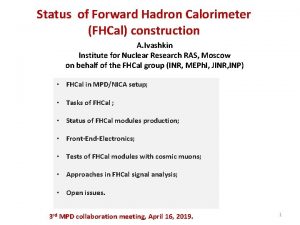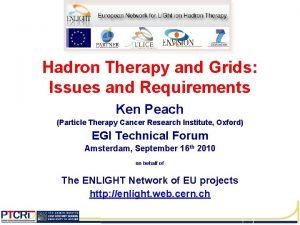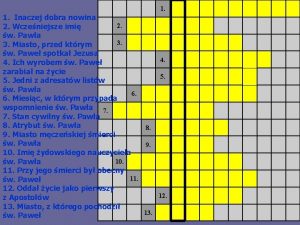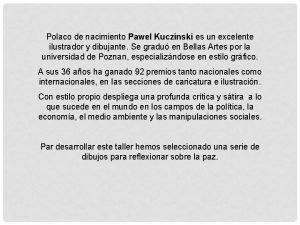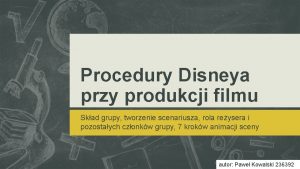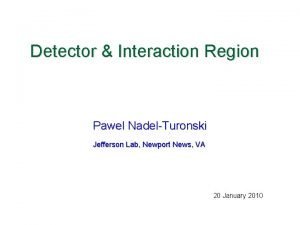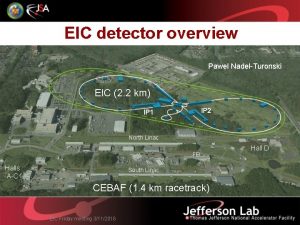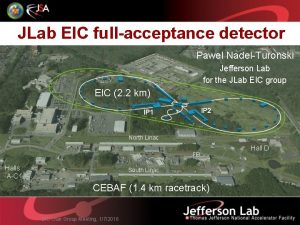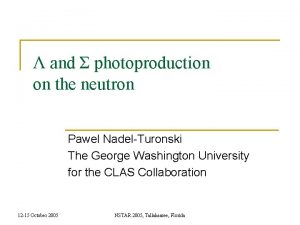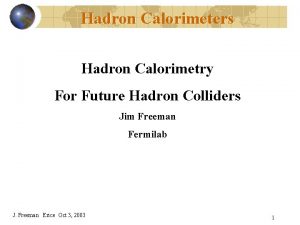Forward detection requirements Pawel NadelTuronski Requirements forward hadron







- Slides: 7

Forward detection requirements Pawel Nadel-Turonski

Requirements forward hadron detection Need to distinguish between physics requirements, spectrometer requirements, subsystem requirements Physics requirements § Diffraction on proton requires good high-XL acceptance § Spatial imaging requires large p. T coverage and moderate resolution § Nuclear measurements are most demanding: high resolution for spectator tagging, low-p. T coverage for coherent nuclear processes, and high-p. T coverage for SRCs, and large range of rigidities for tagging in heavy nuclei Spectrometer optics and accelerator integration § Requirements very demanding – but solution exists § Essential to maintain performance as accelerator evolves Detector subsystems – layout and technology choices § Different technologies for different part of spectrometer § At JLab, requirements are not very demanding – limited R&D needs § Definition of optimal subsystem layout and alignment is needed

Central detector DIRC & TOF Vertex (Si pixel) Central tracker (low-mass DC) Endcap GEM tracker e/π Cherenkov EMcal (HBD with r. TPC? ) ( PWO 4) T OF EMcal (Sci-Fi) EMcal (Shashlyk) Endcap GEM trackers 5 m 3. 2 m electron endcap central barrel gas Dualradiator RICH (top view) hadron endcap Hcal PWO 4 EMcal Dipole with field exclusion for e-beam 2 m e Hcal GEM trackers Space for additional muon chambers solenoid coil (1. 5 - 3 T) mirrors TOF sens ors Flux return yoke (muon chambers? ) EMcal (Shaslyk) Fluxreturn coils aerogel Flux-return coils Modular aerogel RICH p/A

Particles in hadron endcap Mostly forward mesons and photons from current jet Mesons from target + high-p. T nucleons Nucleons and ion fragments only (+ nuclear photons)

Particles in forward spectrometer 4. zero-degree neutrons and (boosted) nuclear photons (high-resolution calorimeters) 2 Tm dipole Compensating solenoid 20 Tm dipole Aperture-free drift space Forward hadron spectrometer solenoid S-shaped dipole configuration optimizes neutron acceptance 1. spectator protons are bent strongly Spectator proton angle after dipole is 75 mrad with respect to the beam. Roman pots possible but not needed! K+ at proton beam energy behaves similarly to spectator proton from deuterium. Charged mesons will mostly be detected before ion FFQs. Detectors in compensating solenoid can provide limited coverage, but losses in FFQs will be large (n, γ) ZDC p e 3. low-p. T recoil protons (high-resolution roman pots at focal point 43 m downstream from IP) 2. high-p. T recoil protons and intermediate-mass fragments (low-mass roman pots / detectors before third dipole) Fragment PID from p and d. E/dx

Subsystem requirements 1. Spectator tagging § Large exit angle allows use of a simple tracker (>100 microns) in air 2. Intermediate ion fragment / high-p. T proton detection § Shaped exit windows or low-mass Roman pots and detectors needed § This region currently requires most design / integration work § Micromegas would be a good low-mass tracker candidate for RPs 3. Low-p. T proton detection at focal plane § High-resolution Si-trackers needed to obtain < 0. 3 mrad resolution (matching beam momentum spread) in relatively short (~ 2 m) Roman pot § Optimization of tracker is straightforward (d. E/dx measurement at the end) 4 High-resolution ZDC for neutrons and photons § Dual-readout or particle flow Hcal can provide resolutions of 30%/sqrt(E) § Need 1. 3 cm spatial resolution at 40 m to achieve 0. 3 mrad (as for tracker) § High-resolution EMcal in front of Hcal for boosted nuclear photons

Physics drivers for requirements Near-beam acceptance (low-p. T: need to cover down to ~0 Ge. V/c) § Requirements from diffraction (high x. L) and spatial imaging (low –t = p. T 2) § Coherent nuclear processes also require near-beam detection and to push mass range, but good angular information is not as important § Key capability - we would want to cover as much as possible! Large apertures (high-p. T need to cover up to ~1 Ge. V/c) § Spatial imaging (large p. T corresponds to core of proton) § High-momentum nucleons for SRCs and, e. g. , geometry tagging § Fragment detection (e. g. , for geometry tagging) in heavy nuclei, etc § Partonic fragmentation (on proton) Resolution (~ Fermi momentum) § Spectator tagging with light nuclei, e. g. , for free neutron structure (~20 Me. V for 50 Ge. V/A deuterium beam) § Useful for spatial imaging – but requirement depends on distributions

